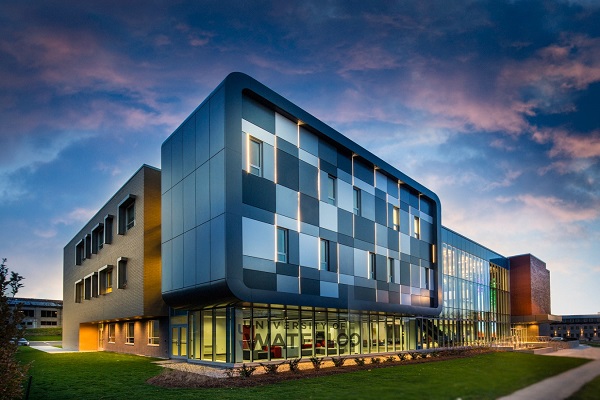University of Waterloo: Researchers and Indigenous students learn about Grand River
On June 15, grade nine students from Six Nations Polytechnic (SNP) and the STEAM Academy program donned their waders to join researchers Charles de Lannoy, Karen Kidd and Waterloo Biology Professor Mark Servos to conduct experiments in the Grand River.
In its first year, this joint initiative led by McMaster University and the University of Waterloo, is a land-based experiential learning approach to science and engineering. The event is a pilot for a micro-credential course in which the students could eventually gain a McMaster University credit by the end of high school.
Electrofishing with Mark Servos
Decked out in their safety equipment, students waited to catch fish with nets after emitting a small electric shock to the water. Once they caught a few, they brought them back to land and put them in a clear tank. Here they learned about how to identify each fish, from where their fins were located to the markings on their bodies.
“Experiential learning is one of the most effective ways to engage with students and people in general,” said Servos, who is also the Canada Research Chair in Water Quality Protection. “It is easy to get excited about aquatic science when you are knee-deep in a river.
“This experience allows us to have a conversation and truly communicate with each other,” Servos said. “I learned a lot from the students. They are so enthusiastic and engaged.”
Engineering and science in action
“It’s a very exciting opportunity to see engineering and science in action, and it’s also fun to just go into the river, cool off on a hot day, explore what these two rivers look like, discover what makes them different, and use technologies and an understanding of ecology to evaluate their health,” said de Lannoy, chemical engineering associate professor at McMaster and one of the lead organizers of the initiative.
Before beginning their work, a student laid tobacco in the water.
“We wanted to establish some protocol before conducting our investigations and environmental work,” said Chris Martin, Indigenous Program Facilitator at SNP. “Placing the tobacco in the river acknowledges where we are and lets creation know what we are about to do. It allows us to bring our minds together before the event.”
Throughout the day, students cycled through three activities.
Water Quality Monitoring and Sensors with Charles de Lannoy
de Lannoy focuses on developing technologies that can continuously monitor the health of the river remotely and make those technologies robust, adaptable and cheaper.
Students were able to use these sensors to test the oxygen in various parts of the river to determine its health. One student remarked how the sensors were like little tentacles. de Lannoy was thrilled with the curiosity of the students, how they asked great questions and devised creative hypotheses.
de Lannoy is proud of what they have accomplished with the STEAM Academy.
“What we’re showcasing is that engineers and scientists can engage with First Nations Youth and they can have really meaningful experiences,” said de Lannoy. “We can really serve this community and I encourage other professors to do more activities like this.”
Bug Collection and Identification with Karen Kidd
Using nets and tweezers, students learned about bugs in the water. While exploring the river, they studied the habitat of insects and critters. Karen Kidd’s favourite thing is to see what’s living under rocks. After scooping up some samples, they perused the samples with tweezers, picking out insect larvae, crayfish, leeches, worms and more.
“It is my impression that high school students don’t get a lot of exposure to environmental sciences, especially hands-on experiences like this one,” said Kidd, School of Earth, Environment & Society professor at McMaster. “I hope they gained a better understanding of some of the challenges our waterways face, and that it will motivate some of them to pursue careers in environmental sciences.”
Kidd, de Lannoy and Servos are part of a research program funded by Global Water Futures called “Co-Creation of Indigenous Water Quality Tools,” led by Dawn Martin-Hill at McMaster.
“With members of Six Nations, we are assessing the health of their waters, fish and wildlife. This was another great opportunity for us to share what we are doing on the Grand River, and to teach them some of the tools we use to understand how humans are affecting our aquatic ecosystems. If it instilled in them a better appreciation of our environment and the need to protect it, then I consider that a win.”
Adriana Johnson, Grade 9 student at SNP, was inspired by the learning and experiences. She has always wanted to get into engineering, and now she wants to focus on doing something involving the environment.
“I remember when you couldn’t even see through the water and it was so polluted, and to see now there’s like so much life and it’s becoming closer to what it was before colonization pollution,” she said. “It makes me want to put more effort into reviving it really.”
Joshua George, another grade 9 student, was surprised by the amount of biodiversity in the water.
“They talked about the amount of mussel species that were in the water and I found it quite interesting,” said George.
Following the field day, students used lab equipment to analyze samples collected from the river at the STEAM Academy in Brantford. Researchers had the opportunity to showcase new sensors they are developing, water testing equipment they frequently use, and digital microscopes to demonstrate fish and invertebrates’ analysis techniques.
“I am sure I learned just as much from the students as they learned from me, added Kidd. “And it was a blast.”

